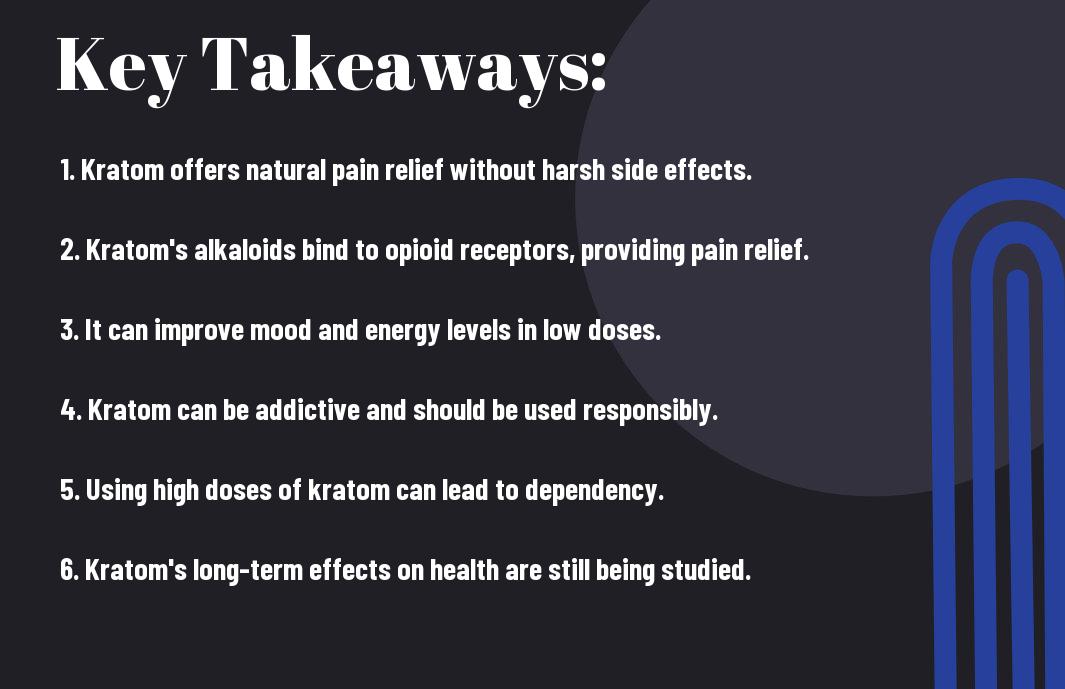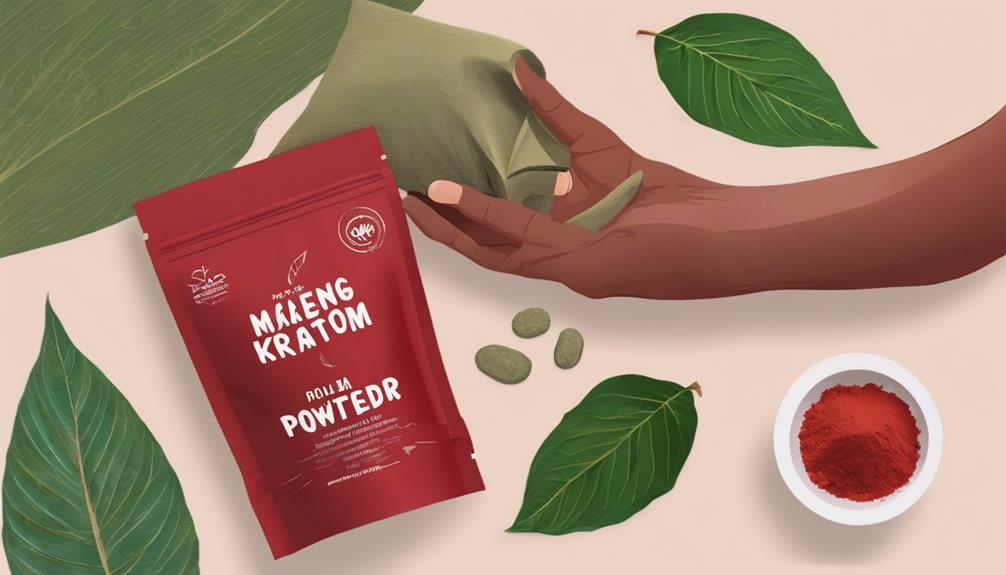Veritably, kratom has been a subject of much controversy and debate in recent years, but its potential as a powerful pain reliever cannot be denied. Derived from the leaves of the Mitragyna speciosa tree, this natural botanical has been used for centuries in traditional medicine to alleviate chronic pain. Kratom contains compounds that bind to opioid receptors in the brain, providing a unique and long-lasting form of pain relief.
Despite its promising benefits, it’s important to approach kratom with caution, as it has the potential for addiction and dependence if not used responsibly. However, with proper education and understanding of its effects, kratom can be a valuable tool for individuals seeking non-pharmaceutical pain management options.
Key Takeaways:
- Kratom is a natural pain reliever: Kratom contains alkaloids that act on the opioid receptors in the brain, providing long-lasting pain relief.
- Multiple strains offer different benefits: There are several strains of kratom, each with unique effects such as pain relief, energy boost, or relaxation. Understanding the differences can help in selecting the right one for your needs.
- Potential for addiction and withdrawal: While kratom can provide effective pain relief, it is important to use it responsibly as it can lead to dependence and withdrawal symptoms if misused.

The Origins and History of Kratom
If you’re curious about kratom, it’s important to first understand where this natural remedy comes from and how it has been used throughout history. The origins of kratom can be traced back to Southeast Asia, where it has been a staple in traditional medicine for centuries.
Geographic and Cultural Roots
Cultural practices surrounding kratom date back to ancient times in Southeast Asia, particularly in countries like Thailand, Malaysia, and Indonesia. The native peoples of these regions have long utilized the leaves of the kratom tree for its various medicinal properties. Kratom has been deeply ingrained in the cultural fabric of these regions, where it has been used for pain relief, energy enhancement, and as a tool for laborers to combat fatigue during long work days.
Traditional Uses and Historic Applications
Cultural history reveals that kratom was traditionally consumed in the form of chewing the raw leaves or brewing them into tea. It was known for its ability to provide long-lasting pain relief, boost energy levels, and improve overall well-being. In addition to its effects on physical well-being, kratom has also been used for its mood-enhancing properties, helping to alleviate stress and anxiety.
Roots of kratom are deeply intertwined with the cultural and traditional practices of Southeast Asian societies. The herb has not only played a vital role in their medicinal traditions but has also been a part of various religious and social ceremonies. Throughout history, kratom has been utilized for its positive effects in pain relief and energy enhancement, while caution must be exercised in its use to avoid potential negative health impacts.

Understanding Kratom: Composition and Varieties
Not many people are aware of the intricate composition and vast varieties of kratom, which play a significant role in its pain-relieving properties. In this chapter, we will delve into the alkaloid profile, active compounds, and the different strains of kratom, shedding light on its complex nature.
Alkaloid Profile and Active Compounds
One of the key components of kratom is its alkaloid profile, which includes compounds such as mitragynine, 7-hydroxymitragynine, and speciociliatine. These active compounds interact with the body’s opioid receptors, providing long-lasting pain relief and a sense of well-being. Understanding the alkaloid composition of kratom is crucial in comprehending its efficacy in managing chronic pain and other health conditions.
Different Strains and Their Effects
Effects of different strains of kratom vary based on their alkaloid content and the regions where they are cultivated. For example, the red vein strains are known for their sedative and analgesic properties, making them effective for pain management and relaxation. On the other hand, the white vein strains are more energizing and stimulating, suitable for enhancing focus and productivity. It’s essential to understand the specific effects of each strain to choose the most suitable one for individual needs.
Kratom enthusiasts report a wide range of positive effects, including pain relief, improved mood, and increased energy. However, it’s crucial to note that excessive consumption or misuse of kratom can lead to adverse effects, such as nausea, dizziness, and dependency. Therefore, it’s important to use kratom responsibly and seek guidance from healthcare professionals to maximize its benefits while minimizing potential risks.
Kratom, alkaloid profile, active compounds, different strains, pain relief, sedative, analgesic, energizing, stimulating, adverse effects, dependency, healthcare professionals

Kratom in Modern Medicine
Unlike many other natural remedies, kratom has found its way into modern medicine despite facing legal and regulatory challenges. The controversial herb has been the subject of lawsuits and debates surrounding its safety and efficacy. Kratom Is Supposed to Relieve Pain and Anxiety. Why Is It …
Scientific Research and Findings on Kratom
Research on kratom’s effects and potential benefits is ongoing, with preliminary findings suggesting its potential as a pain reliever and anxiolytic. However, the herb’s safety profile and potential for addiction have raised concerns among medical professionals and regulatory agencies.
Despite the ongoing research, there is still much to be understood about kratom’s mechanisms of action and long-term effects on the human body.
Kratom’s Role in Pain Management
To date, most of the scientific research on kratom has focused on its pain-relieving properties. Several studies have shown that kratom may act as an effective pain reliever, especially for chronic conditions. Some researchers believe that its pain-relieving effects are due to its interactions with opioid receptors in the brain.
Pain relief, opioid receptors, chronic conditions
Methods of Kratom Consumption
For centuries, people have been using kratom in various forms to experience its medicinal benefits. The methods of consuming kratom have evolved over time, and there are now numerous ways to ingest this natural pain-relief herb.
Traditional and Contemporary Intake Methods
Consumption of kratom traditionally involved chewing the leaves directly or brewing them into a tea. In contemporary times, kratom is consumed in the form of capsules, powders, and tinctures. Another popular method is mixing kratom powder into beverages or food, making it easier to consume for those with a sensitive palate. With the rising popularity of kratom, there is also a growing market for kratom-infused products such as gummies and energy drinks.
Dosage and Potency Considerations
Kratom dosage and potency considerations are crucial for experiencing its benefits without any adverse effects. It is important to start with a low dosage and gradually increase to find the right balance for the desired effects. The potency of kratom can vary based on factors such as the strain, quality, and individual tolerance levels. Understanding these considerations can help users avoid the potential risks associated with consuming kratom.
Methods for determining the appropriate dosage and potency of kratom include consulting with experienced users or professionals and conducting thorough research on reputable sources. Considering the potency and dosage of kratom is essential to ensure a safe and enjoyable experience.
Overall, it is important to highlight the traditional and contemporary intake methods when consuming kratom and to be mindful of the dosage and potency for a safe and beneficial experience.
Legal and Regulatory Landscape
Now, let’s delve into the legal and regulatory landscape surrounding kratom. Understanding the current status and potential future of legislation is crucial for anyone interested in using this natural remedy for pain relief.
Current Legal Status Around the World
Around the world, the legal status of kratom varies greatly. In many countries, kratom is legal and readily available for purchase. However, there are also regions where kratom is strictly regulated or even banned altogether. It’s important for individuals to research and understand the legal status of kratom in their specific location to avoid any legal complications.
Future of Kratom Legislation
On the horizon, the future of kratom legislation is uncertain. Current efforts are underway in some areas to further regulate or ban the use of kratom, citing potential health risks and concerns. However, there is also a growing movement to expand access to kratom, advocating for its potential benefits and low risk of addiction compared to traditional pain medications.
It’s crucial for advocates and users of kratom to stay informed and involved in the legislative process to ensure that their access to this natural remedy is protected.
Potential Risks and Controversies
After gaining popularity as a natural remedy for pain relief, kratom has also faced its fair share of controversies and potential risks. While many advocates praise its effectiveness, critics and medical professionals have expressed concerns about its safety and potential long-term impact on health.
Safety, Side Effects, and Contraindications
With any herbal supplement or alternative medicine, it is important to consider the potential safety risks, side effects, and contraindications. Some reports have linked kratom use to adverse effects such as nausea, dizziness, constipation, and even more severe issues like liver damage. Additionally, there are concerns about potential interactions with other medications, making it crucial for individuals to consult with a healthcare professional before incorporating kratom into their wellness routine.
Debates and Concerns in the Medical Community
Contraindications and concerns about kratom use have sparked ongoing debates within the medical community. While some researchers acknowledge its potential as a natural analgesic, others remain skeptical about its safety and efficacy, especially in the absence of rigorous clinical trials. The lack of regulation and standardized dosages also adds to the overall uncertainty surrounding its use as a long-term solution for pain management.
Any individual considering kratom for pain relief should carefully weigh the potential risks and benefits and seek guidance from a qualified healthcare provider for personalized advice and monitoring. With ongoing debates and limited scientific evidence, it is essential to approach kratom use with caution and to prioritize safety and well-being.
Personal Experiences and Testimonials
Keep
Chronic Pain Sufferers’ Accounts
Chronic pain sufferers have shared their experiences with using kratom for pain relief, with many reporting significant improvements in their symptoms. From arthritis to fibromyalgia, individuals who have struggled with long-term pain have found relief through the use of kratom. They have reported that kratom not only helps to manage their pain, but also provides a sense of well-being and improved quality of life.
Impact of Kratom on Quality of Life and Well-being
Personal accounts of the impact of kratom on quality of life and well-being have been overwhelmingly positive. People have reported being able to regain control of their lives and enjoy activities they once thought were impossible due to pain. Kratom has also been credited with improving mental health and providing a much-needed sense of relief and relaxation.
Impact of Kratom on Quality of Life and Well-being has been significant for many chronic pain sufferers and individuals struggling with long-term health issues. The positive impact on mental health and overall well-being cannot be understated, as it has provided relief and a renewed sense of hope for many.
How Does Kratom provide Long-lasting Pain Relief?
Kratom for opiate withdrawal has been found to provide long-lasting pain relief by interacting with opioid receptors in the brain. This natural plant can help manage chronic pain without the risk of addiction or tolerance. Many individuals have turned to kratom as an alternative to traditional opioid medications for managing pain.
Can Kratom Help with Pain Relief as Well as Mood and Mental Well-being?
Yes, Kratom has been known to have a positive impact on mood and mental well-being. Many individuals report feeling uplifted and more positive after taking Kratom. In addition to its potential pain relief properties, Kratom’s impact on mood makes it a popular choice for those seeking a natural remedy.
The Unraveling The Mysteries Of Kratom – The Secret To Long-lasting Pain Relief
The mysteries of kratom have finally been unraveled, and it has been revealed as the secret to long-lasting pain relief. With its natural compounds and chemical properties, kratom has proven to be an effective alternative for those seeking relief from chronic pain. Its ability to activate opioid receptors in the brain without causing respiratory depression sets it apart from traditional opioid medications, making it an appealing option for those looking for a safer, more sustainable pain management solution. As more research continues to be conducted on kratom, its potential for treating a wide range of ailments beyond pain relief is becoming increasingly evident, solidifying its place in the world of natural medicine.
The understanding of kratom’s properties and its potential for long-lasting pain relief provides hope for those struggling to find an effective and sustainable solution for their chronic pain. As the medical community continues to explore the benefits and risks of kratom, it is important for individuals to exercise caution and seek guidance from healthcare professionals before incorporating it into their pain management regimen. With responsible use and further scientific investigation, kratom has the potential to improve the lives of countless individuals in need of long-lasting pain relief without the negative side effects associated with traditional opioid medications.
FAQ
Q: What is Kratom?
A: Kratom is a tropical tree native to Southeast Asia, known for its leaves that contain compounds with psychotropic effects. It has been traditionally used for its stimulant and pain-relieving properties.
Q: How does Kratom provide pain relief?
A: Kratom contains alkaloids that act on the opioid receptors in the brain, producing analgesic effects similar to opioids. This can provide long-lasting pain relief without the risk of respiratory depression or addiction.
Q: Is Kratom safe to use for pain relief?
A: When used responsibly and in moderation, Kratom can be safe for pain relief. However, like any substance, it can have adverse effects if misused or abused. It’s important to follow dosage guidelines and be aware of potential side effects.
Q: What are the potential side effects of using Kratom?
A: Common side effects of Kratom include nausea, constipation, and dizziness. More serious side effects can occur with high doses, including respiratory depression, seizures, and liver damage. It’s important to be aware of these risks and use Kratom responsibly.
Q: Is Kratom legal, and where can it be purchased?
A: The legal status of Kratom varies by country and state. In some places, it is legal and can be purchased from specialty stores or online vendors. In other areas, it may be restricted or banned. It’s important to research the laws in your area before purchasing Kratom.










